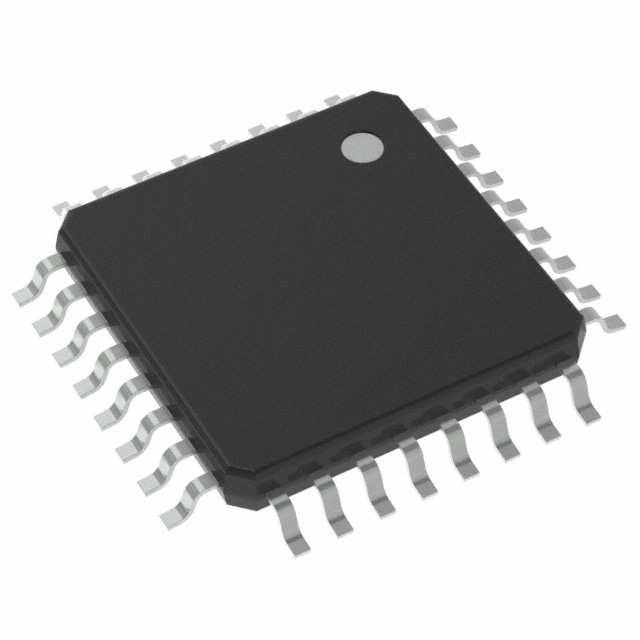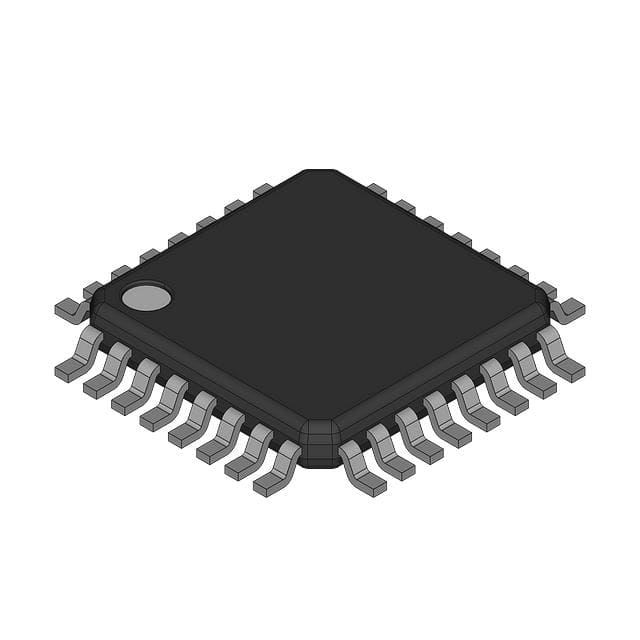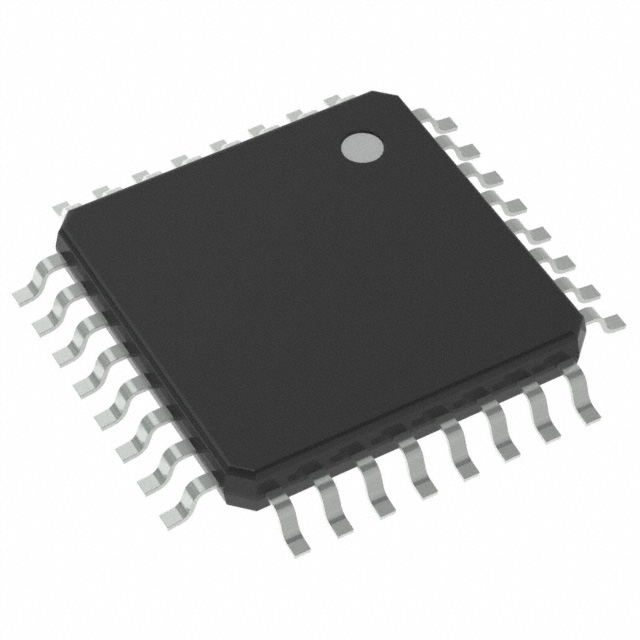Microcontroller ATmega series: ATMEGA8A-AU Introduction
The ATMEGA8A-AU is a popular 8-bit microcontroller from Microchip Technology (formerly Atmel) and part of the ATmega series. It is based on the AVR architecture and is designed for a wide variety of embedded applications. It offers a blend of low power consumption, high performance, and a rich set of peripherals, making it a versatile choice for many low-cost, low-power designs.
ATMEGA8A-AU Core and Performance
Core: 8-bit AVR microcontroller
Clock Speed: Up to 16 MHz
Architecture: RISC-based (Reduced Instruction Set Computing) for efficient processing
Instruction Set: AVR 8-bit instruction set, optimized for speed and simplicity
Data Bus Width: 8-bit
Memory
Flash Memory: 8 KB of In-System Programmable Flash memory
SRAM: 1 KB of Static RAM
EEPROM: 512 bytes of Electrically Erasable Programmable Read-Only Memory (EEPROM)
Used for storing data that should persist between power cycles
ATMEGA8A-AU Pin and Package Types
ATMEGA8A-AU comes in an 88-pin QFN (Quad Flat No-lead) package, which is suitable for surface-mount applications. It is also available in other package types, including PDIP (Plastic Dual Inline Package), TQFP, and QFN
ATMEGA8A-AU Applications
The ATMEGA8A-AU is well-suited for a wide range of embedded applications, including:
Consumer electronics: Remote controls, toys, and small household appliances
Industrial control: Low-end controllers for motors, sensors, or actuators
Automotive: Simple applications like lighting, alarms, or simple control tasks
Medical devices: Portable health monitoring systems and equipment
IoT devices: Basic smart devices with simple communication requirements
Robotics: For controlling small robots, servos, and sensors
Advantages of ATMEGA8A-AU
Low Cost: Affordable, making it ideal for cost-sensitive applications.
High Performance: Despite being an 8-bit MCU, the AVR architecture is fast and efficient for many simple embedded applications.
Rich Peripheral Set: The presence of various interfaces such as SPI, USART, I2C, ADC, and timers makes it versatile.
Ease of Use: Supported by the Arduino ecosystem, which makes it accessible for hobbyists, developers, and educators.
Low Power: Multiple sleep modes allow the ATMEGA8A-AU to operate in battery-powered, low-power applications.
ATMEGA8A-AU similar comparison
ATMEGA8A-AU vs ATMEGA8U2-AU vs ATTINY88-15AZ vs ATMEGA8U2-AUR
| Feature | ATMEGA8A-AU | ATMEGA8U2-AU | ATTINY88-15AZ | ATMEGA8U2-AUR |
|---|---|---|---|---|
| Image |  |  |  |  |
| Manufacturer | Microchip Technology | Microchip Technology | Microchip Technology | Microchip Technology |
| Core | AVR (8-bit) | AVR (8-bit) | AVR (8-bit) | AVR (8-bit) |
| Clock Speed | Up to 16 MHz | Up to 16 MHz | Up to 20 MHz | Up to 16 MHz |
| Flash Memory | 8 KB | 8 KB | 8 KB | 8 KB |
| SRAM | 1 KB | 1 KB | 512 Bytes | 1 KB |
| EEPROM | 512 Bytes | 512 Bytes | 512 Bytes | 512 Bytes |
| GPIO Pins | 23 | 23 | 14 | 23 |
| Timers | 3x 8-bit Timers | 3x 8-bit Timers | 2x 8-bit Timers | 3x 8-bit Timers |
| ADC Channels | 8 channels, 10-bit ADC | 8 channels, 10-bit ADC | 8 channels, 10-bit ADC | 8 channels, 10-bit ADC |
| Communication Interfaces | 1x SPI, 1x USART, 1x I2C | 1x SPI, 1x USART, 1x I2C | 1x SPI, 1x USART, 1x I2C | 1x SPI, 1x USART, 1x I2C |
| PWM Channels | 6 PWM Channels | 6 PWM Channels | 4 PWM Channels | 6 PWM Channels |
| Operating Voltage | 2.7V to 5.5V | 2.7V to 5.5V | 2.7V to 5.5V | 2.7V to 5.5V |
| Package Type | LQFP-32 | LQFP-32 | TSSOP-20, SOIC-20 | LQFP-32 |
| Temperature Range | -40°C to +85°C | -40°C to +85°C | -40°C to +85°C | -40°C to +85°C |
| USB Support | No | Yes (Full-Speed USB 2.0) | No | Yes (Full-Speed USB 2.0) |
| Low Power Modes | Yes | Yes | Yes | Yes |
| In-System Programming (ISP) | Yes | Yes | Yes | Yes |
| Package Size | 32 Pins | 32 Pins | 20 Pins | 32 Pins |
ATMEGA8A-AU and ATMEGA8U2-AU are very similar in terms of memory, GPIO pins, and peripherals, but ATMEGA8U2-AU adds USB 2.0 Full-Speed support, which is beneficial for USB-connected devices.
ATTINY88-15AZ is a smaller and lower-pin count option, with fewer GPIOs but still offering important peripherals like SPI, USART, and I2C. It's a good choice for compact applications where USB support is not needed.
ATMEGA8U2-AUR is almost identical to the ATMEGA8U2-AU, but in a TQFP package, making it suitable for different form factor requirements.
ATMEGA8A-AU Datasheet
ATMEGA8A-AU Development and Programming Tools
Development Tools:
AVR Studio (now Atmel Studio): IDE for development, debugging, and simulation
Arduino Compatibility: The ATMEGA8A is compatible with the Arduino platform, which makes it easy for hobbyists and beginners to program and develop applications.
AVR-GCC: Compiler for C/C++ development
AVRDUDE: A utility to program the ATMEGA8A via ISP (In-System Programming)
Programming:
ISP (In-System Programming): Supports programming via SPI interface
JTAG for debugging (if supported)
Summary
The ATMEGA8A-AU is a low-cost, low-power, 8-bit microcontroller with a rich set of peripherals, making it suitable for a wide range of simple embedded applications. Its AVR architecture, wide voltage range, and programming flexibility make it an attractive choice for hobbyists and professionals alike, particularly in low-cost consumer electronics, robotics, and control systems. While it is not the most powerful microcontroller on the market, its ease of use and availability in various packages make it a versatile and popular choice for many projects.
ATMEGA8A-AU FAQs
What is the ATMEGA8A-AU?
The ATMEGA8A-AU is an 8-bit microcontroller based on the AVR architecture by Microchip Technology (formerly Atmel). It is part of the ATmega series and offers a variety of features, including 8 KB flash memory, 1 KB SRAM, 512 bytes EEPROM, multiple timers, ADC channels, and communication interfaces such as USART, SPI, and I2C. It is well-suited for embedded applications requiring low power and high efficiency.
What is the maximum clock speed of the ATMEGA8A-AU?
The ATMEGA8A-AU can run at a maximum clock speed of 16 MHz. This is suitable for many low-power, cost-effective embedded applications.
What development tools are available for the ATMEGA8A-AU?
You can use the following development tools for the ATMEGA8A-AU:
AVR Studio (Atmel Studio): A free integrated development environment (IDE) for AVR microcontrollers.
Arduino IDE: The ATMEGA8A-AU is compatible with the Arduino platform, so you can easily program it using the Arduino IDE.
AVR-GCC: The AVR-GCC compiler can be used to write programs in C/C++.
JTAG/ISP: You can use In-System Programming (ISP) or JTAG to program the microcontroller, and tools like AVRISP mkII, USBasp, or STK500 can be used for flashing the chip.
How do I program the ATMEGA8A-AU?
The ATMEGA8A-AU can be programmed using the In-System Programming (ISP) interface. Common tools for programming include:
USBasp: A USB programmer for AVR microcontrollers.
AVRISP mkII: An official programmer from Microchip for AVR microcontrollers.
Arduino IDE: If you're using the ATMEGA8A-AU in an Arduino-based project, you can program it using the Arduino IDE with the appropriate board settings and bootloader.
What is the operating voltage range of the ATMEGA8A-AU?
The ATMEGA8A-AU operates within a voltage range of 2.7V to 5.5V, making it suitable for a wide range of embedded applications, from battery-powered systems to 5V logic devices.
How many GPIO pins are available on the ATMEGA8A-AU?
The ATMEGA8A-AU has a total of 23 General-Purpose Input/Output (GPIO) pins. These pins can be configured as digital input or output and are also capable of handling analog signals through the ADC channels.
What are the communication interfaces available on the ATMEGA8A-AU?
The ATMEGA8A-AU supports the following communication interfaces:
USART (Universal Synchronous/Asynchronous Receiver Transmitter) for serial communication.
SPI (Serial Peripheral Interface) for high-speed data transfer.
I2C (Inter-Integrated Circuit) for communication with other I2C devices.
These interfaces are useful for connecting the microcontroller to external sensors, displays, or other microcontrollers.
How many ADC channels does the ATMEGA8A-AU have?
The ATMEGA8A-AU features an 8-channel, 10-bit ADC (Analog-to-Digital Converter). The ADC allows you to convert analog signals (such as temperature, light, or sensor data) into digital values for processing by the microcontroller.
Can the ATMEGA8A-AU be used in battery-powered devices?
Yes, the ATMEGA8A-AU is suitable for battery-powered applications. It features low power consumption and offers power-saving modes such as idle mode and power-down mode. The device can run on a wide voltage range (2.7V to 5.5V), making it suitable for various battery-powered systems.
What is the maximum current that the ATMEGA8A-AU can source or sink from its I/O pins?
The ATMEGA8A-AU can typically source or sink 20 mA per I/O pin. However, the total current drawn from all I/O pins should not exceed the microcontroller's total current rating. Exceeding this can damage the chip or reduce its performance.
How is the ATMEGA8A-AU different from other ATmega series microcontrollers?
The ATMEGA8A-AU is a low-cost, low-power 8-bit microcontroller in the ATmega series. It has less memory and fewer peripherals compared to higher-end models like the ATMEGA32 or ATMEGA128. However, it still offers a solid set of features, making it an excellent choice for simple applications requiring basic I/O, analog-to-digital conversion, and serial communication.
Can I use the ATMEGA8A-AU with the Arduino platform?
Yes, the ATMEGA8A-AU can be used with the Arduino platform. It is compatible with the Arduino environment if the proper bootloader is installed. In fact, it shares many similarities with other Arduino-compatible chips, making it a good choice for beginners and hobbyists.
Microchip
在庫 : 19452

